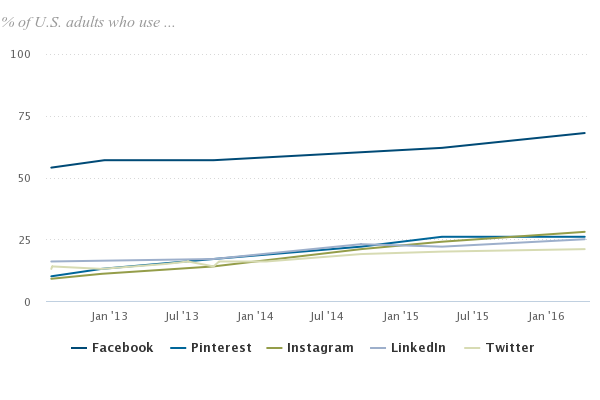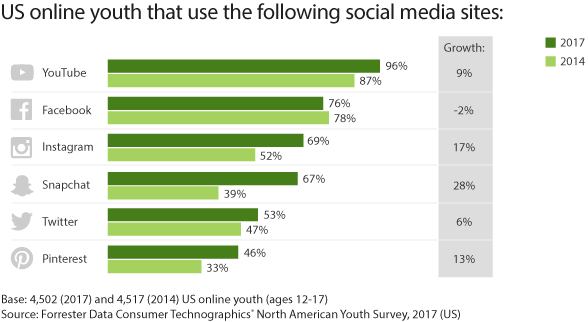Author: Christina Newberry / Source: Hootsuite Social Media Management

Planning your social media marketing strategy requires a solid understanding of what each social network has to offer in terms of user base, demographics, business results, and more. Here, we examine some of the key Facebook statistics all marketers need to know to develop an effective Facebook marketing plan.
Facebook user statistics
1. Facebook has more users than any other social network
2.07 billion monthly active users, to be exact. That’s more than a third of the entire population of the world.
That number may seem overwhelming, but with a solid understanding of exactly who those users are—and how they use the network—you can develop a strategy to find and engage your most important customers.
2. Far more American adults use Facebook than use any other social network
Sixty-eight percent of U.S. adults, according to Pew Research. Compare that to a mere 28 percent for Instagram, the next-most-highly-used social platform.

3. They’re far more likely to be millennials than senior citizens
It’s probably not surprising that millennials use Facebook more than their grandparents do, but the difference in adoption rates may be surprising. While 88 percent of U.S. adults aged 18 to 29 use Facebook, the rate is only 36 percent among those aged 65 and over.
In fact, usage declines with each age cohort above 29, with 79 percent adoption among U.S. adults aged 30 to 49 and 61 percent among those aged 50 to 64.
4. The gender split is fairly even
Women use Facebook at a very slightly higher rate than men, with 69 percent of U.S. adult women using the service, compared to 67 percent of U.S. men. That difference is not significant when it comes to the actual number of men versus women on the platform, so marketers can effectively use Facebook to reach both.
5. Facebook users are likely to have some college education
Seventy-seven percent of U.S. adults with at least some college education use Facebook, compared to 56 percent of those who have a high school education or less.
6. And some cash
Those higher education levels mean Facebook users have relatively high income levels: The adoption rate is highest in the $75,000+ per year income bracket (76 percent), and lowest in the less than $30,000 bracket (65 percent).
Those earning $30,000 to $49,000 and $50,000 to $75,000 have adoption rates of 68 percent and 70 percent, respectively.
Keep in mind that while high income earners are best represented on Facebook, a large majority of people in all income levels are on Facebook, so you shouldn’t rule it out as a tool for reaching any income group.
7. Teens think Facebook is uncool
Forrester Research found that 34 percent of online U.S. teenagers think that Facebook is “for old people.”
8. But they use it anyway
Seventy-six percent of 12- to 17-year-olds still use the network. In fact, only YouTube has higher adoption among this young demographic. Still, while YouTube’s adoption rate is growing among teens (from 87 percent in 2014 to 96 percent in 2017), Facebook’s has dropped slightly, from 78 to 76 percent.

9. And they’ll even accept their parents’ friend requests
Families with teens tend to be multigenerational Facebook users: A survey from Common Sense Media and SurveyMonkey found that 79 percent of teens who use Facebook are Facebook friends with their parents.
10. Facebook users are an international crowd
Only 239 million of Facebook’s 2.07 billion monthly active users (MAUs) live in the United States or Canada—that’s only 11.5 percent.
There are 364 million MAUs in Europe, 794 million in Asia-Pacific, and 675 million in the rest of the world, making it an excellent network for reaching a global audience.
11. And they’re multilingual, too
With those numbers in mind, perhaps it’s not surprising that more than half of Facebook’s users speak a language other than English.
Facebook’s artificial intelligence translates 4.5 billion posts and comments every day. Those translation services allow readers to get the gist of your posts in their native language, but automatic translation can never convey the full depth of meaning in your copy. If you have customers in multiple countries, it may be worth creating…
Peter Bordes Jr
Founder & Managing Partner Trajectory Ventures. Lifetime entrepreneur, CEO, Board Member, mentor, advisor and investor.
Obsessed with the infinite realm of possibility in disruptive innovation driving global digital transformation in technology, cloud-based infrastructure, artificial intelligence, data, DevOps, fintech, robotics, aerospace, blockchain and digital media and advertising.

